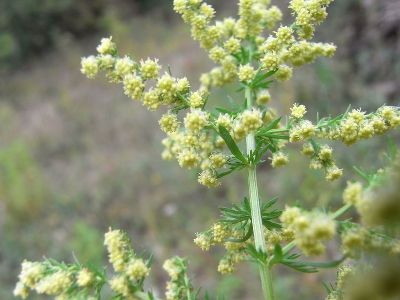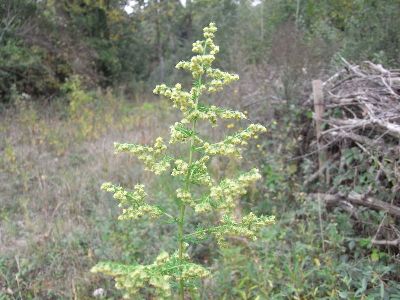Artemisia annua L. (SE-Eur.) – A rare and usually ephemeral alien. First recorded as a wool alien near Pepinster (valley of river Vesdre) in 1891. Exceptionally observed as such at least until 1949. Occasionally seen elsewhere, for instance in Montigny-sur-Sambre (1931), Jette (1958), St-Job-in-‘t-Goor (1958), St-Katelijne-Waver (1959),… often without an obvious vector of introduction. Known at least since 1943 from Anderlecht (Brussel), especially around a disused railway yard (Petit-Île) and the canal Brussel-Charleroi (Saintenoy-Simon & al. 1995). Artemisia annua grows in sun-exposed, dry or temporarily wet wasteland, ruderal roadsides, canal banks and other strongly antrophogenic habitats. Recent infrastructural works have considerably diminished the number of populations in Anderlecht. Another large population, near an old clay-pit in Rumst (Verloove 2002), lately disappeared. Occasionally seen elsewhere but usually ephemeral (for instance in Gent 2003, 2005). In 2010 seen in abundance on a demolition site in Ville-Pommeroeul.
Elsewhere in Europe Artemisia annua is locally increasing (see for instance Brandes & Janssen 1991, Brandes & Müller 2004), in southern Europe mostly in riparian (natural) habitats.
A Belgian record of Artemisia messerschmidtiana Besser was in error for A. annua.
 |
 |
 |
 |
Selected literature:
Aftab T., Ferreira J.F.S., Khan M.M.A. & Naeem M. (eds.) (2013) Artemisia annua - Pharmacology and Biotechnology. VII + 373 p.
Anzalone B. (1978) La diffusione di Artemisia annua L. in Italia. Inform. Bot. Ital. 10 (3): 394-396.
Brandes D. & Janssen C. (1991) Artemisia annua L. – ein auch in Deutschland eingebürgerter Neophyt. Flor. Rundbr. 25(1): 28-36.
Brandes D. & Müller M. (2004) Artemisia annua L. – ein erfolgreicher Neophyt in Mitteleuropa? Tuexenia 24: 339-358 [available online at: http://rzbl04.biblio.etc.tu-bs.de:8080/docportal/receive/DocPortal_document_00001585].
Cristaudo A. & Lo Giudice R. (1999) Artemisia annua L. (Asteraceae) new for the Sicilian flora. Flora Medit. 9: 277-280.
Follak S., Dullinger S., Kleinbauer I., Moser D. & Essl F. (2013) Invasion dynamics of three allergenic invasive Asteraceae (Ambrosia trifida, Artemisia annua, Iva xanthiifolia) in central and eastern Europe. Preslia 85: 41-61. [available online at: http://www.preslia.cz/P131Follak.pdf]
Müller M. & Brandes D. (1997) Growth and development of Artemisia annua l. on different soil types. Verhandlungen der Gesellschaft für Ökologie 27: 453-460 [available online at: http://rzbl04.biblio.etc.tu-bs.de:8080/docportal/receive/DocPortal_document_00001761
Saintenoy-Simon J., Godefroid S. & Verhelpen B. (1995) Groupe Flore Bruxelloise. Notes floristiques relatives à la Région de Bruxelles-Capitale (1991-1993). Adoxa 6-7: 27-37.
Verloove F. (2002) Ingeburgerde plantensoorten in Vlaanderen. Mededeling van het Instituut voor Natuurbehoud n° 20: 227 p.
Verloove F. (2006) Artemisia annua. In: Van Landuyt W., Hoste I., Vanhecke L., Van den Bremt P., Vercruysse W. & De Beer D., Atlas van de flora van Vlaanderen en het Brussels gewest. Instituut voor Natuur- en Bosonderzoek, Nationale Plantentuin van België en Flo.Wer: 160-161.

